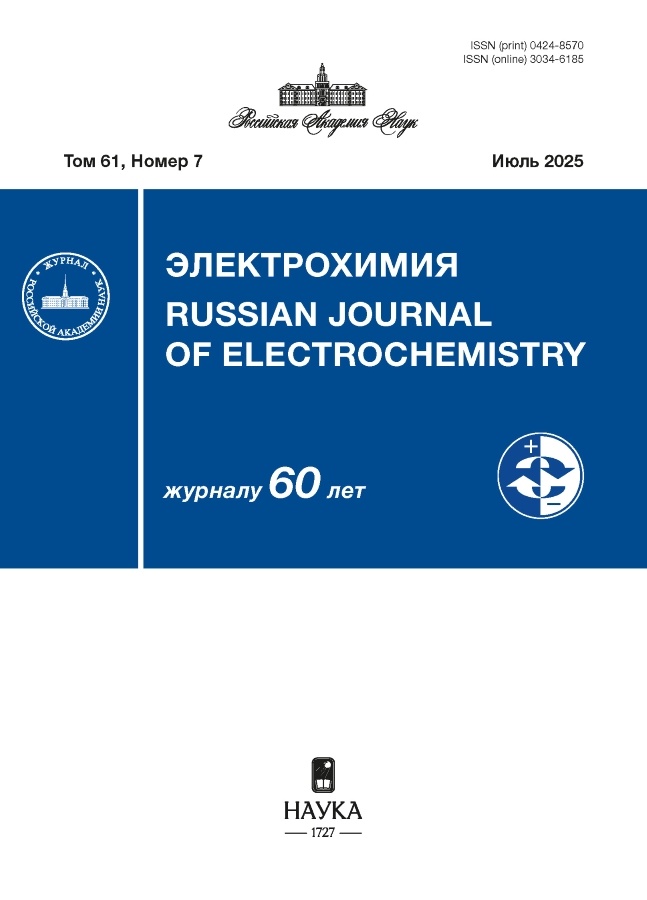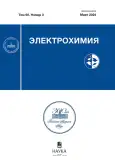Влияние природы порообразователей на микроструктуру анода ТОТЭ на основе NiO и 10YSZ, сформированного гибридной 3D-печатью
- Авторы: Мальбахова И.А.1, Багишев А.С.1, Воробьев А.М.1, Борисенко Т.А.1, Титков А.И.1
-
Учреждения:
- Институт химии твердого тела и механохимии СО РАН
- Выпуск: Том 60, № 3 (2024)
- Страницы: 210-220
- Раздел: Статьи
- URL: https://modernonco.orscience.ru/0424-8570/article/view/671537
- DOI: https://doi.org/10.31857/S0424857024030063
- EDN: https://elibrary.ru/RBKMWG
- ID: 671537
Цитировать
Полный текст
Аннотация
В данной работе были послойно сформированы аноды на основе оксида никеля и оксида циркония, допированного оксидом иттрия, методом гибридной струйной 3D-печати с лазерной обработкой. Был определен гранулометрический состав композита NiO/Zr0.9Y0.1O2 (10YSZ) и реологические характеристики печатных паст на его основе. Проведены эксперименты по печати трехмерных тестовых объектов с использованием разработанной керамической пасты. Было изучено влияние дополнительно введенных в состав порообразователей – графита и картофельного крахмала – на реологические характеристики пасты. Полученные образцы несущих анодов были изучены комплексом физико-химических методов для определения морфологических и структурных характеристик.
Ключевые слова
Полный текст
Об авторах
И. А. Мальбахова
Институт химии твердого тела и механохимии СО РАН
Автор, ответственный за переписку.
Email: malbakhova.inna@yandex.ru
Россия, Новосибирск
А. С. Багишев
Институт химии твердого тела и механохимии СО РАН
Email: malbakhova.inna@yandex.ru
Россия, Новосибирск
А. М. Воробьев
Институт химии твердого тела и механохимии СО РАН
Email: malbakhova.inna@yandex.ru
Россия, Новосибирск
Т. А. Борисенко
Институт химии твердого тела и механохимии СО РАН
Email: malbakhova.inna@yandex.ru
Россия, Новосибирск
А. И. Титков
Институт химии твердого тела и механохимии СО РАН
Email: malbakhova.inna@yandex.ru
Россия, Новосибирск
Список литературы
- Singla, M.K., Nijhawan, P., and Oberoi, A.S., Hydrogen fuel and fuel cell technology for cleaner future: a review, Environ. Sci. Pollut. Res., 2021, vol. 28, no. 13, p. 15607.
- Parra, D., Valverde, L., Pino, F.J., and Patel, M.K., A review on the role, cost and value of hydrogen energy systems for deep decarbonisation, Renew. Sust. Energ. Rev., 2019, vol. 101, p. 279.
- Khan, M.Z., Iltaf, A., Ishfaq, H.A., Khan, F.N., Tanveer, W.H., Song, R.H., Mehran, M.T., Saleem, M., Hussain, A., and Masaud, Z., Flat-tubular solid oxide fuel cells and stacks: A review, J. Asian Ceram. Soc., 2021, vol. 9, no. 3, p. 745.
- Tai, X.Y., Zhakeyev, A., Wang, H., Jiao, K., Zhang, H., and Xuan, J., Accelerating fuel cell development with additive manufacturing technologies: state of the art, opportunities and challenges, Fuel Cells, 2019, vol. 19, no. 6, p. 650.
- Zouridi, L., Garagounis, I., Vourros, A., Marnellos, G.E., and Binas, V., Advances in Inkjet-Printed Solid Oxide Fuel Cells, Adv. Mater. Technol., 2022, vol. 7, no. 7, 2101491.
- Pelz, J.S., Ku, N., Meyers, M.A., and Vargas-Gonzalez, L.R., Additive manufacturing of structural ceramics: a historical perspective, J. Mater. Res. Technol., 2021, vol. 15, p. 670.
- Sun, C., Wang, Y., McMurtrey, M.D., Jerred, N.D., Liou, F., and Li, J., Additive manufacturing for energy: A review, Appl. Energy, 2021, vol. 282, p. 116041.
- Pham, T.T., Tu, H.P., Dao, T.D., To, T.D., Doan, D.C.T., and Dang, M.C., Fabrication of an anode functional layer for an electrolyte-supported solid oxide fuel cell using electrohydrodynamic jet printing, Adv. Nat. Sci.: Nanosci. Nanotechnol., 2019, vol. 10, no. 1, p. 015004.
- Jang, I. and Kelsall, G.H., Fabrication of 3D NiO-YSZ structures for enhanced performance of solid oxide fuel cells and electrolysers, Electrochem. Commun., 2022, vol. 137, p. 107260.
- Sobolev, A., Stein, P., and Borodianskiy, K., Synthesis and characterization of NiO colloidal ink solution for printing components of solid oxide fuel cells anodes, Ceram. Int., 2020, vol. 46, no. 16, p. 25260.
- Ghazanfari, A., Li, W., Leu, M. C., Watts, J. L., and Hilmas, G. E., Additive manufacturing and mechanical characterization of high density fully stabilized zirconia, Ceram. Int., 2017, vol. 43, no. 8, p. 6082.
- Xing, B., Cao, C., Zhao, W., Shen, M., Wang, C., and Zhao, Z., Dense 8 mol% yttria-stabilized zirconia electrolyte by DLP stereolithography, J. Eur. Ceram. Soc., 2020, vol. 40, no. 4, p. 1418.
- Kuterbekov, K.A., Nikonov, A.V., Bekmyrza, K.Z., Pavzderin, N.B., Kabyshev, A.M., Kubenova, M.M., and Aidarbekov, N., Classification of Solid Oxide Fuel Cells, Nanomaterials, 2022, vol. 12, no. 7, p. 1059.
- Prakash, B.S., Kumar, S.S., and Aruna, S.T., Properties and development of Ni/YSZ as an anode material in solid oxide fuel cell: A review, Renew. Sust. Energ. Rev., 2014, vol. 36, p. 149.
- Sauerwein, M., Zlopasa, J., Doubrovski, Z., Bakker, C., and Balkenende, R., Reprintable paste-based materials for additive manufacturing in a circular economy, Sustainability, 2020, vol. 12, no. 19, p. 8032.
- Sukeshini, A.M., Cummins, R., Reitz, T.L., and Miller, R.M., Inkjet Printing of Anode Supported SOFC: Comparison of Slurry Pasted Cathode and Printed Cathode, Electrochem. solid-state lett., 2009, vol. 12, p. B176.
- Deng, X. and Petric, A., Effect of anode porosity and pore size on electrochemical performance, ECS Proceedings Volumes, 2003, vol. 1, p. 653.
- Clemmer, R.M. and Corbin, S.F., Effect of graphite pore‐forming agents on the sintering characteristics of Ni/YSZ composites for solid oxide fuel cell applications, Int. J. Appl. Ceram., 2012, vol. 9, no. 6, p. 1022.
- Zhou, J., Liu, Q., Zhang, L., Pan, Z., & Chan, S.H., Influence of pore former on electrochemical performance of fuel-electrode supported SOFCs manufactured by aqueous-based tape-casting, Energy, 2016, vol. 115, p. 149.
- Хатко, З.Н., Титов, С.А., Ашинова, А.А., Колодина, Е.М. Влияние комбинирования пектиновых веществ на вязкость их водных растворов. Вестник ВГУИТ. 2019. Т. 81. С. 133.
Дополнительные файлы

Примечание
Публикуется по материалам IX Всероссийской конференции с международным участием “Топливные элементы и энергоустановки на их основе”, Черноголовка, 2022.
















